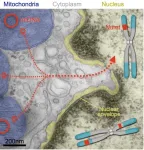(Press-News.org) NEW YORK, NY (Aug. 22, 2024)--As direct descendants of ancient bacteria, mitochondria have always been a little alien.
Now a study shows that mitochondria are possibly even stranger than we thought.
Mitochondria in our brain cells frequently fling their DNA into the nucleus, the study found, where the DNA becomes integrated into the cells’ chromosomes. And these insertions may be causing harm: Among the study’s nearly 1,200 participants, those with more mitochondrial DNA insertions in their brain cells were more likely to die earlier than those with fewer insertions.
“We used to think that the transfer of DNA from mitochondria to the human genome was a rare occurrence,” says Martin Picard, mitochondrial psychobiologist and associate professor of behavioral medicine at Columbia University Vagelos College of Physicians and Surgeons and in the Robert N. Butler Columbia Aging Center. Picard led the study with Ryan Mills of the University of Michigan.
“It’s stunning that it appears to be happening several times during a person’s lifetime, Picard adds. “We found lots of these insertions across different brain regions, but not in blood cells, explaining why dozens of earlier studies analyzing blood DNA missed this phenomenon.”
Mitochondrial DNA behaves like a virus
Mitochondria live inside all our cells, but unlike other organelles, mitochondria have their own DNA, a small circular strand with about three dozen genes. Mitochondrial DNA is a remnant from the organelle’s forebears: ancient bacteria that settled inside our single-celled ancestors about 1.5 billion years ago.
In the past few decades, researchers discovered that mitochondrial DNA has occasionally “jumped” out of the organelle and into human chromosomes.
“The mitochondrial DNA behaves similar to a virus in that it makes use of cuts in the genome and pastes itself in, or like jumping genes known as retrotransposons that move around the human genome,” says Mills.
The insertions are called nuclear-mitochondrial segments—NUMTs (“pronounced new-mites”)—and have been accumulating in our chromosomes for millions of years.
“As a result, all of us are walking around with hundreds of vestigial, mostly benign, mitochondrial DNA segments in our chromosomes that we inherited from our ancestors,” Mills says.
Mitochondrial DNA insertions are common in the human brain
Research in just the past few years has shown that “NUMTogenesis” is still happening today.
“Jumping mitochondrial DNA is not something that only happened in the distant past,” says Kalpita Karan, a postdoc in the Picard lab who conducted the research with Weichen Zhou, a research investigator in the Mills lab. “It’s rare, but a new NUMT becomes integrated into the human genome about once in every 4,000 births. This is one of many ways, conserved from yeast to humans, by which mitochondria talk to nuclear genes.”
The realization that new inherited NUMTs are still being created made Picard and Mills wonder if NUMTs could also arise in brain cells during our lifespan.
“Inherited NUMTs are mostly benign, probably because they arise early in development and the harmful ones are weeded out,” says Zhou. But if a piece of mitochondrial DNA inserts itself within a gene or regulatory region, it could have important consequences on that person’s health or lifespan. Neurons may be particularly susceptible to damage caused by NUMTs because when a neuron is damaged, the brain does not usually make a new brain cell to take its place.
To examine the extent and impact of new NUMTs in the brain, the team worked with Hans Klein, assistant professor in the Center for Translational and Computational Neuroimmunology at Columbia, who had access to DNA sequences from participants in the ROSMAP aging study (led by David Bennett at Rush University). The researchers looked for NUMTs in different regions of the brain using banked tissue samples from more than 1,000 older adults.
Their analysis showed that nuclear mitochondrial DNA insertion happens in the human brain—mostly in the prefrontal cortex—and likely several times over during a person’s lifespan.
They also found that people with more NUMTs in their prefrontal cortex died earlier than individuals with fewer NUMTs. “This suggests for the first time that NUMTs may have functional consequences and possibly influence lifespan,” Picard says. “NUMT accumulation can be added to the list of genome instability mechanisms that may contribute to aging, functional decline, and lifespan.”
Stress accelerates NUMTogenesis
What causes NUMTs in the brain, and why do some regions accumulate more than others?
To get some clues, the researchers looked at a population of human skin cells that can be cultured and aged in a dish over several months, enabling exceptional longitudinal “lifespan” studies.
These cultured cells gradually accumulated several NUMTs per month, and when the cells’ mitochondria were dysfunctional from stress, the cells accumulated NUMTs four to five times more rapidly.
“This shows a new way by which stress can affect the biology of our cells,” Karan says. “Stress makes mitochondria more likely to release pieces of their DNA and these pieces can then ‘infect’ the nuclear genome,” Zhou adds. It’s just one way mitochondria shape our health beyond energy production.
“Mitochondria are cellular processors and a mighty signaling platform,” Picard says. “We knew they can control which genes are turned on or off. Now we know mitochondria can even change the nuclear DNA sequence itself.”
Additional information
The study, titled “Somatic nuclear mitochondrial DNA insertions are prevalent in the human brain and accumulate over time in fibroblasts,” was published Aug. 22 in PLOS Biology.
All authors: Weichen Zhou (University of Michigan), Kalpita R. Karan (Columbia), Wenjin Gu (Michigan), Hans-Ulrich Klein (Columbia), Gabriel Sturm (Columbia and University of California, San Francisco), Philip L. De Jager (Columbia), David A. Bennett (Rush University Medical Center), Michio Hirano (Columbia), Martin Picard (Columbia), and Ryan E Mills (Michigan).
This work was supported by grants from the U.S. National Institutes of Health (R01AG066828, R21HG011493, and P30AG072931), the Baszucki Brain Research Fund, and the University of Michigan Alzheimer’s Disease Center Berger Endowment.
The authors report no conflicts of interest.
###
Columbia University Irving Medical Center (CUIMC) is a clinical, research, and educational campus located in New York City. Founded in 1928, CUIMC was one of the first academic medical centers established in the United States of America. CUIMC is home to four professional colleges and schools that provide global leadership in scientific research, health and medical education, and patient care including the Vagelos College of Physicians and Surgeons, the Mailman School of Public Health, the College of Dental Medicine, the School of Nursing. For more information, please visit cuimc.columbia.edu.
END
Mitochondria are flinging their DNA into our brain cells
These DNA insertions may be linked to early death
2024-08-22
ELSE PRESS RELEASES FROM THIS DATE:
Revealing DNA behavior in record time
2024-08-22
“DNA, RNA and proteins are the key players to regulate all processes in the cells of our body,” Leiden Professor John van Noort explains. “To understand the (mis-)functioning of these molecules, it is essential to uncover how their 3D structure depends on their sequence and for this it is necessary to measure them one molecule at a time. However, single-molecule measurements are laborious and slow, and the number of possible sequence variations is massive.”
From decades to days
Now the team of scientists developed an innovative tool, called SPARXS (Single-molecule Parallel Analysis for Rapid eXploration ...
Columbia receives $400 million gift for biomedical research
2024-08-22
NEW YORK, NY (Aug. 22, 2024)--Columbia University announced today a new $400 million gift from Roy and Diana Vagelos, which will secure Columbia’s leadership in biomedical science research and education and produce a vast array of compelling opportunities for improving society’s health and wellbeing. The gift is the single largest ever made to Columbia’s medical school and, taken together with their previous giving, establishes Roy and Diana as the most generous donors in the history of Columbia University.
A ...
Air pollution harms mental health worse in New York’s historically redlined neighborhoods
2024-08-22
BUFFALO, N.Y. — Air pollution is bad for mental health. That much is clear. Now, new research shows the impact may be even worse in neighborhoods that were historically redlined.
University at Buffalo researchers looked at 17 cities across New York State where longstanding federal housing policies once denied neighborhoods with people of color from receiving mortgages. Although this practice was outlawed in 1968, the researchers found that elevated levels of air pollutants in these neighborhoods of the state ...
Meteor showers shed light on where comets formed in the early solar system
2024-08-22
An international team of 45 researchers studying meteor showers has found that not all comets crumble the same way when they approach the Sun. In a paper published in the journal Icarus this week, they ascribe the differences to the conditions in the protoplanetary disk where comets formed 4.5 billion years ago.
“The meteoroids we see as meteors in the night sky are the size of small pebbles,” said lead author and SETI Institute and NASA Ames meteor astronomer Peter Jenniskens. “They are, in fact, the same size as the pebbles that collapsed into comets during the formation of ...
ChatGPT shows promise in answering patients' questions to urologists
2024-08-22
August 22, 2024 — The groundbreaking ChatGPT chatbot shows potential as a time-saving tool for responding to patient questions sent to the urologist's office, suggests a study in the September issue of Urology Practice®, an Official Journal of the American Urological Association (AUA). The journal is published in the Lippincott portfolio by Wolters Kluwer.
The artificial intelligence (AI) tool generated "acceptable" responses to nearly one-half of a sample of real-life patient questions, according to the new research ...
T cells manipulate the memory of innate immune cells
2024-08-22
Research from Radboud university medical center reveals that T cells from the adaptive immune system can manipulate the memory of innate immune cells. Previously, it was believed that the memory of innate immune cells operated independently. This surprising connection opens up new possibilities for the treatment of various diseases. A mouse model shows that no immunosuppressive drugs are needed after an organ transplantation if this interaction between T cells and the innate immunity is temporarily blocked after the transplantation.
The adaptive immune ...
Immune cells have a metabolic backup plan for accessing their anti-cancer playbook
2024-08-22
GRAND RAPIDS, Mich. (Aug. 22, 2024) — Immune cells use two different routes to produce acetyl-CoA, an essential metabolite required to fight infection and cancer, reports a study led by Van Andel Institute scientists.
The findings, published in the Journal of Experimental Medicine, could help improve immunotherapies by revealing how diet can boost immune cell function.
“Like any good system, immune cells have a plan A and a plan B,” said Russell Jones, Ph.D., the study’s corresponding author and chair of VAI’s Department of Metabolism and Nutritional ...
A 3D ion Magnet, the new experimental frontier for quantum information processing
2024-08-22
Many quantum devices, from quantum sensors to quantum computers, use ions or charged atoms trapped with electric and magnetic fields as a hardware platform to process information.
However, current trapped-ion systems face important challenges. Most experiments are limited to one-dimensional chains or two-dimensional planes of ions, which constrain the scalability and functionality of quantum devices. Scientists have long dreamed of stacking these ions into three-dimensional structures, but this has been very difficult ...
A potential pathway may guide new therapies for inflammatory bowel disease and other inflammatory diseases
2024-08-22
Philadelphia, August 22, 2024 – There is a critical unmet need to help tighten and maintain a healthy intestinal barrier and treat a leaky gut. Researchers have now found that a unique strain of probiotic bacteria, Bifidobacterium bifidum BB1, enhances intestinal barrier function and protects against penetration of bacteria and various harmful agents in the intestine. The findings, detailed in an article in The American Journal of Pathology, published by Elsevier, can help advance the development of novel, targeted, naturally occurring probiotic therapy for patients with inflammatory bowel disease (IBD) and other inflammatory diseases, such as fatty liver disease or alcoholic liver ...
CU researchers awarded $1.35 million grant to develop decision support technology for long-term care facilities
2024-08-22
Researchers from the University of Colorado College of Nursing and CU School of Medicine on the Anschutz Medical Campus were awarded a $1.35 million grant from the Agency for Healthcare Research and Quality (AHRQ) to design and implement technologies that improve resident safety and employee wellbeing at long-term care facilities.
“Long-term care facilities in the United States are in crisis, they’re facing low resources and high staff turnover,” CU Nursing Associate Professor and ...
LAST 30 PRESS RELEASES:
Global psychiatry mourns Professor Dan Stein, visionary who transformed mental health science across Africa and beyond
KIST develops eco-friendly palladium recovery technology to safeguard resource security
Statins significantly reduce mortality risk for adults with diabetes, regardless of cardiovascular risk
Brain immune cells may drive more damage in females than males with Alzheimer’s
Evidence-based recommendations empower clinicians to manage epilepsy in pregnancy
Fungus turns bark beetles’ defenses against them
There are new antivirals being tested for herpesviruses. Scientists now know how they work
CDI scientist, colleagues author review of global burden of fungus Candida auris
How does stroke influence speech comprehension?
B cells transiently unlock their plasticity, risking lymphoma development
Advanced AI dodel predicts spoken language outcomes in deaf children after cochlear implants
Multimodal imaging-based cerebral blood flow prediction model development in simulated microgravity
Accelerated streaming subgraph matching framework is faster, more robust, and scalable
Gestational diabetes rose every year in the US since 2016
OHSU researchers find breast cancer drug boosts leukemia treatment
Fear and medical misinformation regarding risk of progression or recurrence among patients with breast cancer
Glucagonlike peptide-1 receptor agonists and asthma risk in adolescents with obesity
Reviving dormant immunity: Millimeter waves reprogram the immunosuppressive microenvironment to potentiate immunotherapy without obvious side effects
Safety decision-making for autonomous vehicles integrating passenger physiological states by fNIRS
Fires could emit more air pollution than previously estimated
A new way to map how cells choose their fate
Numbers in our sights affect how we perceive space
SIMJ announces global collaborative book project in commemoration of its 75th anniversary
Air pollution exposure and birth weight
Obstructive sleep apnea risk and mental health conditions among older adults
How talking slows eye movements behind the wheel
The Ceramic Society of Japan’s Oxoate Ceramics Research Association launches new international book project
Heart-brain connection: international study reveals the role of the vagus nerve in keeping the heart young
Researchers identify Rb1 as a predictive biomarker for a new therapeutic strategy in some breast cancers
Survey reveals ethical gaps slowing AI adoption in pediatric surgery
[Press-News.org] Mitochondria are flinging their DNA into our brain cellsThese DNA insertions may be linked to early death







